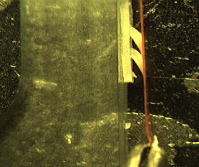Scheme to 'pull electricity from the air' sparks debate
Tiny charges gathered directly from humid air could be harnessed to generate electricity, researchers say.Dr Fernando Galembeck told the American Chemical Society meeting in Boston that the technique exploited a little-known atmospheric effect.
Tests had shown that metals could be used to gather the charges, he said, opening up a potential energy source in humid climates.
However, experts disagree about the mechanism and the scale of the effect.
"The basic idea is that when you have any solid or liquid in a humid environment, you have absorption of water at the surface," Dr Galembeck, from the University of Campinas in Brazil, told BBC News.

Electricity collected from the air could become the newest alternative energy source
Scientists once believed that water droplets in the atmosphere were electrically neutral, and remained so even after coming into contact with the electrical charges on dust particles and droplets of other liquids. But new evidence suggested that water in the atmosphere really does pick up an electrical charge.
Galembeck and colleagues confirmed that idea, using laboratory experiments that simulated water’s contact with dust particles in the air. They used tiny particles of silica and aluminum phosphate, both common airborne substances, showing that silica became more negatively charged in the presence of high humidity and aluminum phosphate became more positively charged. High humidity means high levels of water vapor in the air ― the vapor that condenses and becomes visible as “fog” on windows of air-conditioned cars and buildings on steamy summer days.
“This was clear evidence that water in the atmosphere can accumulate electrical charges and transfer them to other materials it comes into contact with,” Galembeck explained. “We are calling this ‘hygroelectricity’, meaning ‘humidity electricity’.”
Collected from: Electricity collected from the air could become the newest alternative energy source
Collected from: Charge Partitioning at Gas−Solid Interfaces: Humidity Causes Electricity Buildup on Metals - Langmuir (ACS Publications)

Professor Fernando Galembeck
Instituto de Química, Universidade Estadual de Campinas, Caixa Postal 6154 – 13084-971 – Campinas – BrazilCollected from: :: FAPESP :: - PFPMCG - Professor Fernando Galembeck
 Sources
Sources BBC News - Scheme to 'pull electricity from the air' sparks debate
http://www.bbc.co.uk/news/technology-11100528
Electricity collected from the air could become the newest alternative energy source
http://portal.acs.org/portal/acs/corg/content?_nfpb=true&_pageLabel=PP_ARTICLEMAIN&node_id=222&content_id=CNBP_025407&use_sec=true&sec_url_var=region1&__uuid=f899de81-a3fe-49a3-ae8c-f505ad2aab37
Charge Partitioning at Gas−Solid Interfaces: Humidity Causes Electricity Buildup on Metals - Langmuir (ACS Publications)
http://pubs.acs.org/doi/abs/10.1021/la102494k
:: FAPESP :: - PFPMCG - Professor Fernando Galembeck
http://www.fapesp.br/materia/5057/pfpmcg/professor-fernando-galembeck.htm
http://www.bbc.co.uk/news/technology-11100528
Electricity collected from the air could become the newest alternative energy source
http://portal.acs.org/portal/acs/corg/content?_nfpb=true&_pageLabel=PP_ARTICLEMAIN&node_id=222&content_id=CNBP_025407&use_sec=true&sec_url_var=region1&__uuid=f899de81-a3fe-49a3-ae8c-f505ad2aab37
Charge Partitioning at Gas−Solid Interfaces: Humidity Causes Electricity Buildup on Metals - Langmuir (ACS Publications)
http://pubs.acs.org/doi/abs/10.1021/la102494k
:: FAPESP :: - PFPMCG - Professor Fernando Galembeck
http://www.fapesp.br/materia/5057/pfpmcg/professor-fernando-galembeck.htm
 Related
Related Can we grab electricity from muggy air? - tech - 26 August 2010 - New Scientist
http://www.newscientist.com/article/dn19367-can-we-grab-electricity-from-muggy-air.html
Electricity collected from the air could become the newest alternative energy source
http://www.physorg.com/news201958072.html
Scientists hope to collect electricity from the air
http://www.gizmag.com/harnessing-electricity-from-the-air/16137/
Pesquisa FAPESP Online
http://revistapesquisa.fapesp.br/?art=2428&bd=1&pg=1&lg=en
Brazil groups sees 'hygroelectricity' as new renewable power source, lightning preventer |
http://ceramics.org/ceramictechtoday/materials-innovations/brazil-groups-sees-hygroelectricity-as-new-renewable-power-source-lightning-preventer/
Energy source of the future: electricity from the air - SmartPlanet
http://www.smartplanet.com/business/blog/smart-takes/energy-source-of-the-future-electricity-from-the-air/10156/
http://www.newscientist.com/article/dn19367-can-we-grab-electricity-from-muggy-air.html
Electricity collected from the air could become the newest alternative energy source
http://www.physorg.com/news201958072.html
Scientists hope to collect electricity from the air
http://www.gizmag.com/harnessing-electricity-from-the-air/16137/
Pesquisa FAPESP Online
http://revistapesquisa.fapesp.br/?art=2428&bd=1&pg=1&lg=en
Brazil groups sees 'hygroelectricity' as new renewable power source, lightning preventer |
http://ceramics.org/ceramictechtoday/materials-innovations/brazil-groups-sees-hygroelectricity-as-new-renewable-power-source-lightning-preventer/
Energy source of the future: electricity from the air - SmartPlanet
http://www.smartplanet.com/business/blog/smart-takes/energy-source-of-the-future-electricity-from-the-air/10156/

































